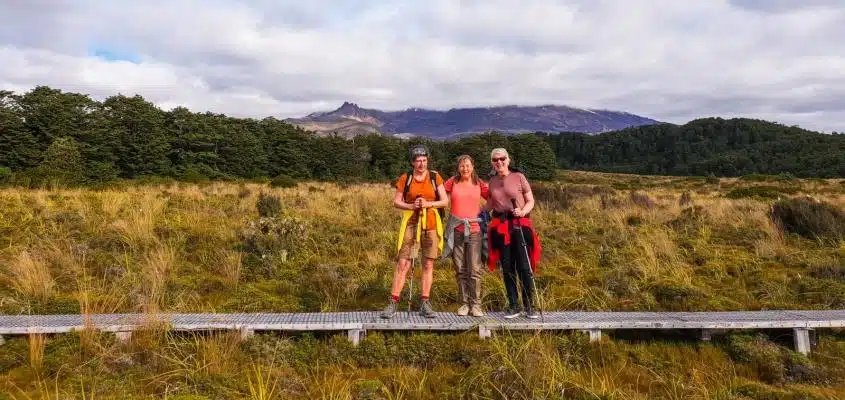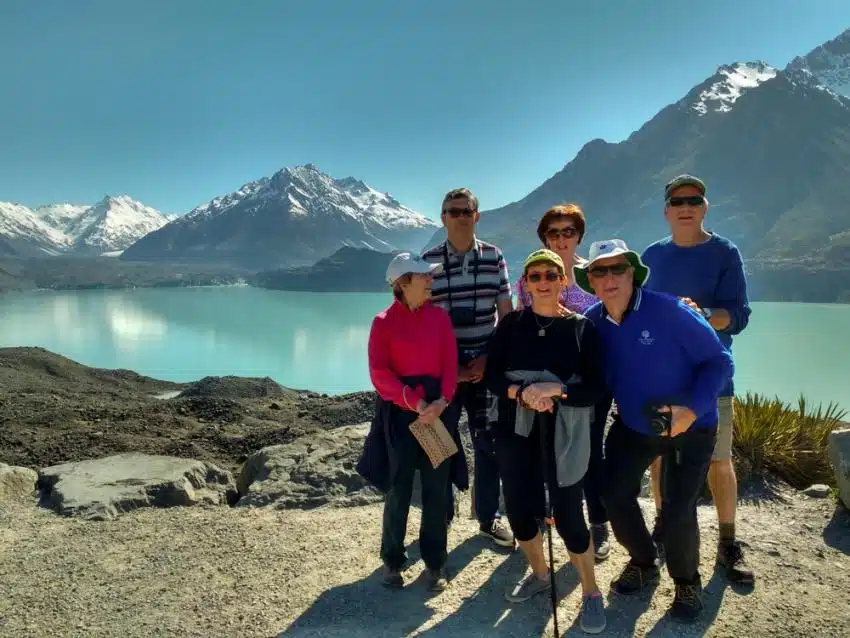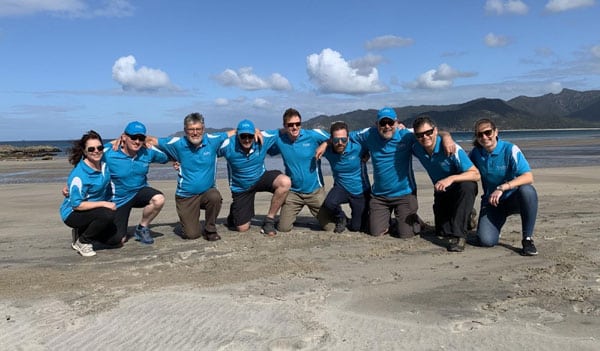Here’s a handy article with everything you’ll need to help you get ready for your New Zealand holiday, complete with a downloadable packing list.
We’ll cover what clothing and other essential items you need to bring, plus a few handy tips to make sure you don’t forget anything important.
Who are we? We’re MoaTrek, we’ve been running small group tours to the very best spots in New Zealand since 1971 and we’ve helped heaps of travellers get ready for their trip.
You’ve finally booked that dream trip to New Zealand and it’s time to start thinking about real preparations, like what to pack. You know that New Zealand is on the other side of the world and you’ve heard a few different stories about the weather, so just what will you need to bring?
What to pack depends on what kind of trip you’re planning
Working out how to pack for your New Zealand trip depends on what kind of holiday you’re planning and when you’re coming.
If you’re coming in the middle of winter for a skiing holiday, what you need to bring is totally different for someone coming in the height of our summer (December to March, opposite from the northern hemisphere) for a relaxing tour with lots of short walks, day cruises and winery lunches.
In this article, we’ll focus on what to pack for New Zealand in summer, spring and autumn, the warmer months of the year we don’t expect to see snow.
Before we go into specifics we’ll talk about a few important points you should know about before you start diving into your wardrobe and spreading all your clothes out on the bed.
New Zealand weather changes a lot at any time of year, so be prepared
Everything you’ve heard about the weather in New Zealand is true, it can change very quickly and pretty much do anything at any time of the year.
Here’s an example, we’re writing this post in early February, a great time of year to travel. Last weekend in Queenstown and Wanaka the temperature was up to around 35 degrees centigrade (95 F), for New Zealand that’s really hot and the whole country was sweltering in a heatwave, but last night we had a southerly change (cold winds come from the South down under) and it was down to 6 degrees centigrade (42 F) overnight! True story.
So, the lesson here is be prepared, even if you’re coming in our summer bring layers, warm jackets, hats and gloves, you won’t regret it.
Think in layers, it will save you lots of space
What do we mean think in layers?
OK, think of your favourite T-shirt, one you love wearing when it’s warm and sunny. That’s one layer. Now think of your favourite long sleeved shirt or blouse, one you can wear over a T-shirt, that’s two layers. Now take your favourite shell or fleece, one that would slip nicely over this ensemble, that’s three layers. Add your favourite waterproof jacket over that and you’re ready for anything New Zealand can throw at you.
If you think about your clothing like this it will help you select clothes that work with others, in terms of colours, fits and styles.
You can get really clever and create something like eight (or is it nine?) different combinations from just three T-shirts, two long sleeved shirts and one shell or fleece. The great thing about lightweight travel clothing these days is that it’s possible to pack light and be protected from the elements while looking really good at the same time.
Before you leave home take a little time to plan out your layers, you’ll be glad you did!

The sun in New Zealand is much stronger than it is in the Northern Hemisphere
You will hear this all the time in New Zealand and it’s really important you heed the warnings and prepare properly.
Because the big hole in the ozone layer is smack bang above New Zealand and Australia, the sun here feels (and is) a lot stronger than in the rest of the world. You will get sunburnt much quicker than you do back home so you really need to take care.
Nothing’s worse than getting sunburnt while you’re on holiday bit as long as you take a few simple precautions it’s easy to avoid.
Especially if you’re sensitive to sunburn, bring long sleeved shirts, a wide brim hat, long trousers and sunscreen with you to wear right from Day 1.
You’ll be more comfortable with clothing you know and are used to (or at least have selected especially for this trip) and will start enjoying your trip from the moment you land if you don’t have to go shopping for your sun protection.
Footwear is really important
Your shoes are really important and will play a big part in how much you enjoy your trip.
The last thing you want to be dealing with during your precious vacation time is breaking in new shoes or dealing with blisters. You want shoes you know are comfortable and won’t give you problems.
The good thing about modern active travel footwear these days is that they are mostly softer fabric and really easy to get used to. The days of having to break in hard leather boots are a thing of the past.
Because your shoes are so important we recommend bringing at least one pair you are used to and know don’t give you problems.
We’ll include footwear in the packing list below, but we recommend one pair of covered active shoes and one pair of open sandals or flip flops are a good idea, plus another tidier pair for going out for dinner.
Handy tip for footwear – If you’re bringing hiking boots or shoes wear them on the plane but pack your sandals in your carry on. We all know that those aeroplane luggage limits can be a bit stingy and if you think you’re going to be pushing it then this is a great way to eek a few more kilos out of your limit.
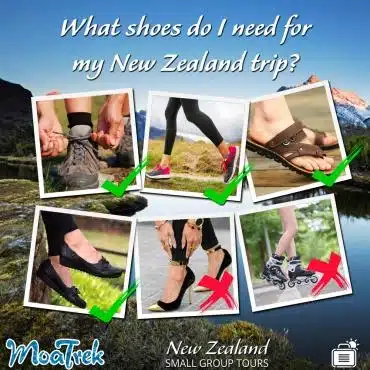
Dress code in New Zealand – it’s a relaxed place
People often ask us if they need to bring a dinner jacket or semi-formal clothing for dining out in restaurants. The short answer is no.
New Zealand is really relaxed and even in the top restaurants in Auckland you’ll be fine in “tidy casual” clothing. Long trousers, a shirt with a collar and covered shoes for men, and a summer dress, trousers, skirt and blouse for ladies will see you fit right in.
If you like dressing up to the nines for dinner then by all means please do, but in most popular restaurants in places like Queenstown, Rotorua and Wellington most people will be more casual.
Packing list for your New Zealand Trip
Here’s what we recommend you pack for your New Zealand trip along with some comments and tips about various items.
Here’s a downloadable and print friendly version of this packing list.
Use your own judgement and common sense, this is a guideline to help you get started.
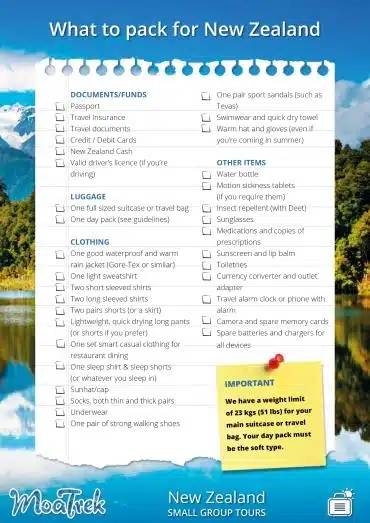
Less is more with packing
Especially if you’re going to be travelling a while, keep it light!
One thing we always hear from guests (and our Kiwi Guides notice for sure!) is how their luggage seems to get heavier over the course of the tour. It’s natural that when you’re on holiday you’ll want to buy a few things but remember whatever you buy needs to fit somewhere so starting off with a bit of space in your luggage will help.
If you’re staying for a few nights in somewhere like Queenstown, a trip to the post office to send a few things home can be a good idea too.
As tempting as it is to pack those books you were planning to read, this is a really easy way to over pack. Most of us love to read on holiday, it’s one of the great pleasures of a vacation for sure but do yourself a favour and keep it to a light paperback or even better, an e-reader. There are plenty of bookshops here and they’ll carry some local titles you’re not likely to see at home, reading a great New Zealand novel while you’re here adds another level to your trip.
Important: For guests on our tours we have a luggage weight limit of 23 kgs (51 pounds) for your suitcase or travel bag. For our Kiwi Guides health and safety, plus vehicle weight laws here in New Zealand it’s really important that we stick to this. Your day pack must be the soft type too, the hard little suitcases won’t fit in the storage on our coaches.
Try this before you leave home
Lay everything that you think you need for your trip out on the bed or floor in a spare room. Now go through each item one by one and ask yourself, do I really need this? Would my trip be just as much fun without this? You’ll probably find yourself answering no to a few items so be brave and leave them at home!
Use packing cubes
Never heard of packing cubes? It’s just a fancy name for stuff sacks or smaller bags really, but they are great. They’re small zipped bags (shaped like cubes) you can put your clothes in before throwing in your suitcase.
You pack everything of one kind of item, say socks and underwear, into one of these cubes and throw it in your suitcase. You’ll get to remember which one holds whichever item you’re looking for and you can find them really easily.
Packing cubes are particularly handy when you’re staying just one night in your accommodation, you can get everything out of your suitcase and back in again without that “how did my room get so messy in such a short time” feeling.
Another tip is to pack an empty cube or bag for laundry. There’s nothing worse than dirty laundry floating round inside your suitcase for a few days before you make your next laundry run.
Pretty much all 3 to 4 star hotels (and all the ones we stay at during our tours) have laundries on site so it’s really easy for you to get washing done while you’re here.
Choose the right bag
The style of trip you’re planning will determine what the right bag is for you.
If you’re planning to walk the Milford Track independently you’ll need the mother of all backpacks. If you’re a guest on one of our small group tours, then a mid-sized suitcase or travel bag will suffice. One with wheels is great and nowadays you can get a suitcase that offers great protection for your clothing and gear while still be super light to carry or pull.
A daypack is really important too for carrying daily essentials with you as often you can’t or don’t want to get to your main suitcase during the day.
Remember your day pack becomes your carry-on luggage on the flight over too, so bear this in mind and make sure it meets the size requirements.
Here’s a great exercise before you go – a week before you leave pack everything you need into your suitcase and what you are planning to carry on the plane in your day pack for a practice run.
You should be 100% self-sufficient and be able to walk and negotiate airports pulling your suitcase and carrying your day bag. If you can’t you need to re pack. Better to find this out at home than at the airport when you’re trying to get check into your flight!
Handy tip for travelling from the USA – get a TSA approved suitcase
Everyone knows how tight border security is these days and if you’ve ever had the inconvenience of having your luggage opened upon entry to the USA you’ll know what a pain and mess it can be.
Many major luggage manufacturers now make “TSA Approved” luggage which the TSA can access with their own keys if they need to check.
No one likes the thought of strangers going through your luggage but if they decide they need to, they will, so at least by having a TSA Approved suitcase you’ll minimize the damage and mess.
What can I put in my carry on luggage?
We all know that there are rules about LAGS (Liquids, Aerosols, Gels and Sprays) but who can remember what you have to do now?
The simple rule is you can carry LAGS on board if they’re in a small container that is 100 ml (3.4 ounces) or less. Put these in a small see through bag and separate when you go through screening to speed up your passage. Anything larger than this must be packed into your check in luggage.
Take the time to get this right before you leave home, if you don’t you will either have to throw the item away or go back to check in and repack. It’s much easier to prepare at home. If you have any medications or anything else you are going to need on the flight then this is the way to go.
Don’t bring any fresh food and declare all our food upon arrival
This is really important but often overlooked. Customs in New Zealand is very strict and if you have any fresh food on you (like fruit) you will be fined at the airport!
This is enforced very strictly and it’s not the nicest way to start your holiday, welcome to New Zealand and by the way, that banana you just took from the airplane will cost you $400!
You are allowed to bring food, but only certain kinds. To be safe declare everything you have and double check your carry on before you reach customs.
Here’s a list of what foods you are allowed to bring into New Zealand.

What NOT to pack for your trip
We’ve spent heaps of time talking about what you need to bring, but how about some things to leave at home. So here goes:
- A big umbrella. If you’ve got a small compact one that folds up nicely then that’s OK but even a mid-sized umbrella is just a pain to travel with. Pick one up here.
- Fancy fancy clothes. High heels, evening gowns, dinner jackets, ties, just leave them at home.
- Hair Dryer. If you’re on one of our tours everywhere we stay has hair dryers available for you.
- A cotton towel. Definitely not. All the hotels you stay in on tour have towels so you don’t need one. A quick dry towel is good to carry, but not a big cotton one.
- Travellers Cheques. Plastic money is the way to go nowadays. Safer, easier and lighter.
Any questions? Drop us a line
We hope you’ve found this useful, the MoaTrek guide on what to pack for your New Zealand trip. Taking the time to get what you need and packing it all correctly will add to the enjoyment of your trip immensely. For MoaTrek guests, any questions about packing or what to bring, drop us a line and we’d love to help.
Read More New Zealand Travel Articles
New Zealand Travel Tips & Common Questions
Can I use my appliances in New Zealand?


